International Marketing Strategy for Kickerco: A Level 7 Report
VerifiedAdded on 2023/05/30
|6
|1422
|166
Report
AI Summary
This report provides a comprehensive analysis of an international marketing strategy for Kickerco, a company expanding its trade globally. It assesses market research requirements, justifies the business case for international marketing, and evaluates potential risks like country, statutory, political, pricing, financial, exchange rate, and interest rate risks. The report emphasizes conducting thorough research on market penetration rates, consumer preferences, and competitor analysis, along with cultural and demographic considerations. Various market entry methods such as direct exporting, franchising, licensing, joint ventures, partnerships, and acquisitions are explored. Operational considerations including mode of entry, budget, and environmental factors like political stability, economic conditions, social and cultural practices, and technological and regulatory environments are discussed. The importance of 'Glocalization' in marketing communication, integrating local culture and practices, is highlighted, along with key legal and statutory requirements like company laws, employment laws, and intellectual property laws. The report concludes with insights from Apple Inc.'s international marketing strategy, emphasizing brand consistency, effective use of local resources, and customized content.
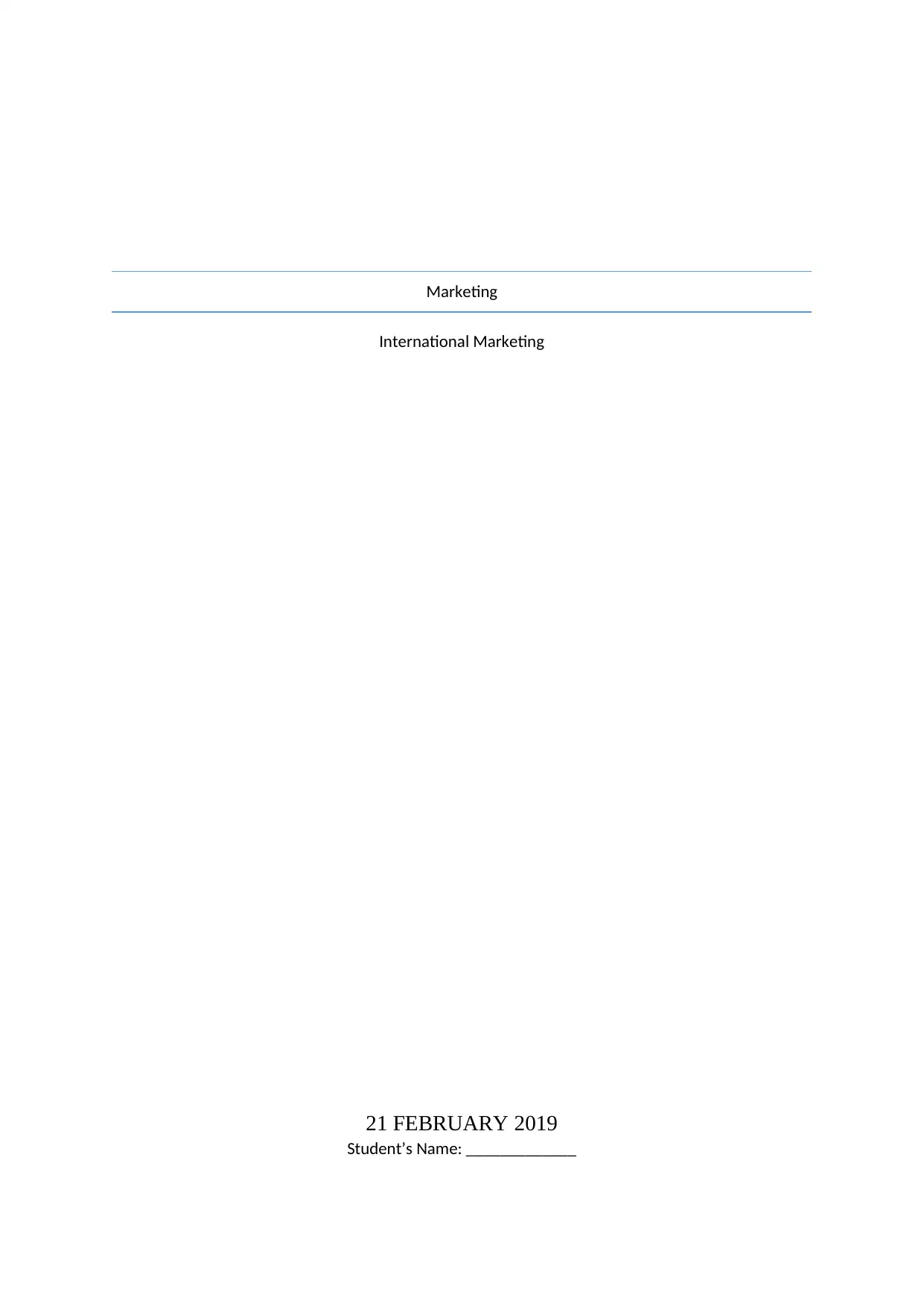
Marketing
International Marketing
21 FEBRUARY 2019
Student’s Name: _____________
International Marketing
21 FEBRUARY 2019
Student’s Name: _____________
Paraphrase This Document
Need a fresh take? Get an instant paraphrase of this document with our AI Paraphraser
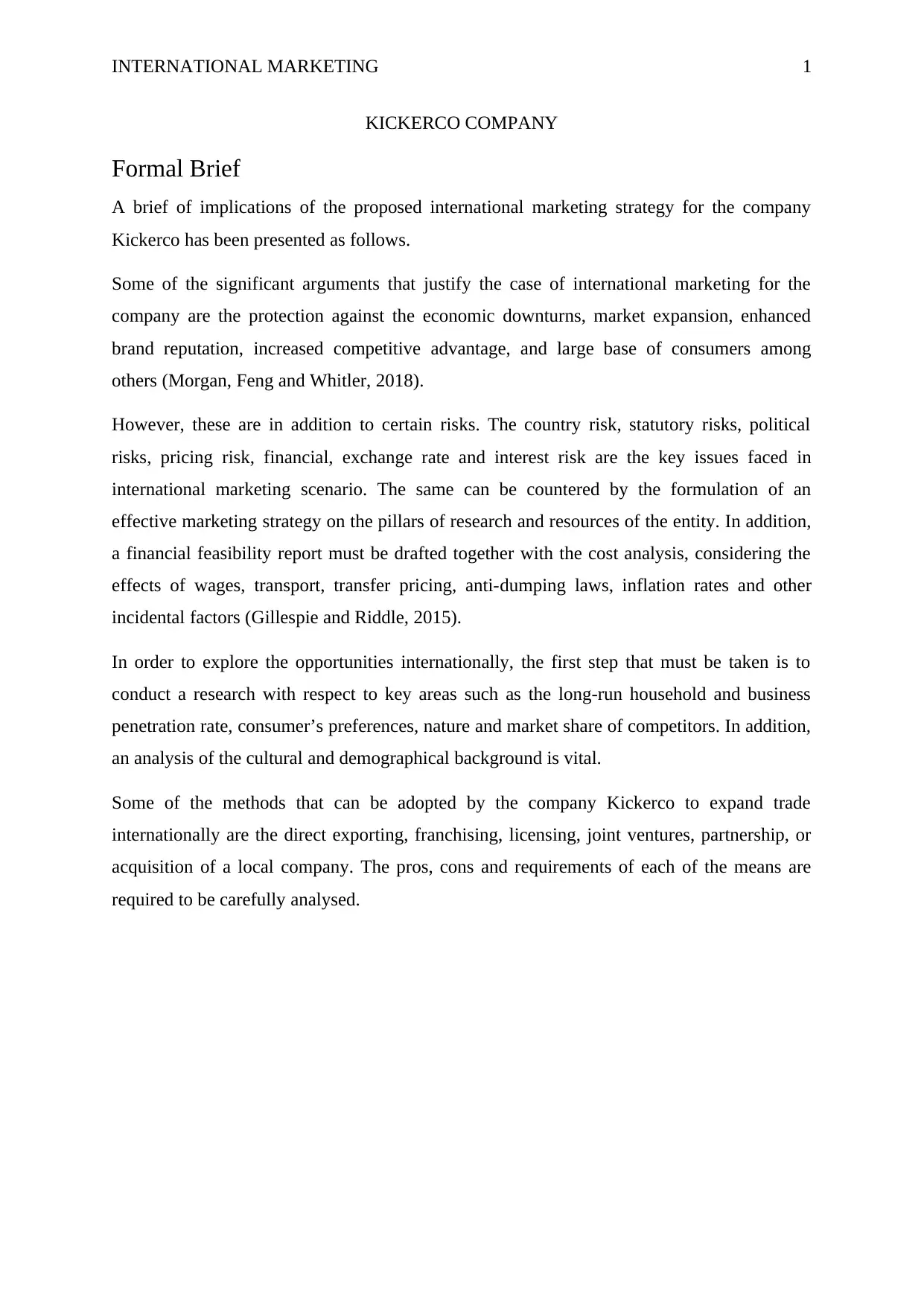
INTERNATIONAL MARKETING 1
KICKERCO COMPANY
Formal Brief
A brief of implications of the proposed international marketing strategy for the company
Kickerco has been presented as follows.
Some of the significant arguments that justify the case of international marketing for the
company are the protection against the economic downturns, market expansion, enhanced
brand reputation, increased competitive advantage, and large base of consumers among
others (Morgan, Feng and Whitler, 2018).
However, these are in addition to certain risks. The country risk, statutory risks, political
risks, pricing risk, financial, exchange rate and interest risk are the key issues faced in
international marketing scenario. The same can be countered by the formulation of an
effective marketing strategy on the pillars of research and resources of the entity. In addition,
a financial feasibility report must be drafted together with the cost analysis, considering the
effects of wages, transport, transfer pricing, anti-dumping laws, inflation rates and other
incidental factors (Gillespie and Riddle, 2015).
In order to explore the opportunities internationally, the first step that must be taken is to
conduct a research with respect to key areas such as the long-run household and business
penetration rate, consumer’s preferences, nature and market share of competitors. In addition,
an analysis of the cultural and demographical background is vital.
Some of the methods that can be adopted by the company Kickerco to expand trade
internationally are the direct exporting, franchising, licensing, joint ventures, partnership, or
acquisition of a local company. The pros, cons and requirements of each of the means are
required to be carefully analysed.
KICKERCO COMPANY
Formal Brief
A brief of implications of the proposed international marketing strategy for the company
Kickerco has been presented as follows.
Some of the significant arguments that justify the case of international marketing for the
company are the protection against the economic downturns, market expansion, enhanced
brand reputation, increased competitive advantage, and large base of consumers among
others (Morgan, Feng and Whitler, 2018).
However, these are in addition to certain risks. The country risk, statutory risks, political
risks, pricing risk, financial, exchange rate and interest risk are the key issues faced in
international marketing scenario. The same can be countered by the formulation of an
effective marketing strategy on the pillars of research and resources of the entity. In addition,
a financial feasibility report must be drafted together with the cost analysis, considering the
effects of wages, transport, transfer pricing, anti-dumping laws, inflation rates and other
incidental factors (Gillespie and Riddle, 2015).
In order to explore the opportunities internationally, the first step that must be taken is to
conduct a research with respect to key areas such as the long-run household and business
penetration rate, consumer’s preferences, nature and market share of competitors. In addition,
an analysis of the cultural and demographical background is vital.
Some of the methods that can be adopted by the company Kickerco to expand trade
internationally are the direct exporting, franchising, licensing, joint ventures, partnership, or
acquisition of a local company. The pros, cons and requirements of each of the means are
required to be carefully analysed.
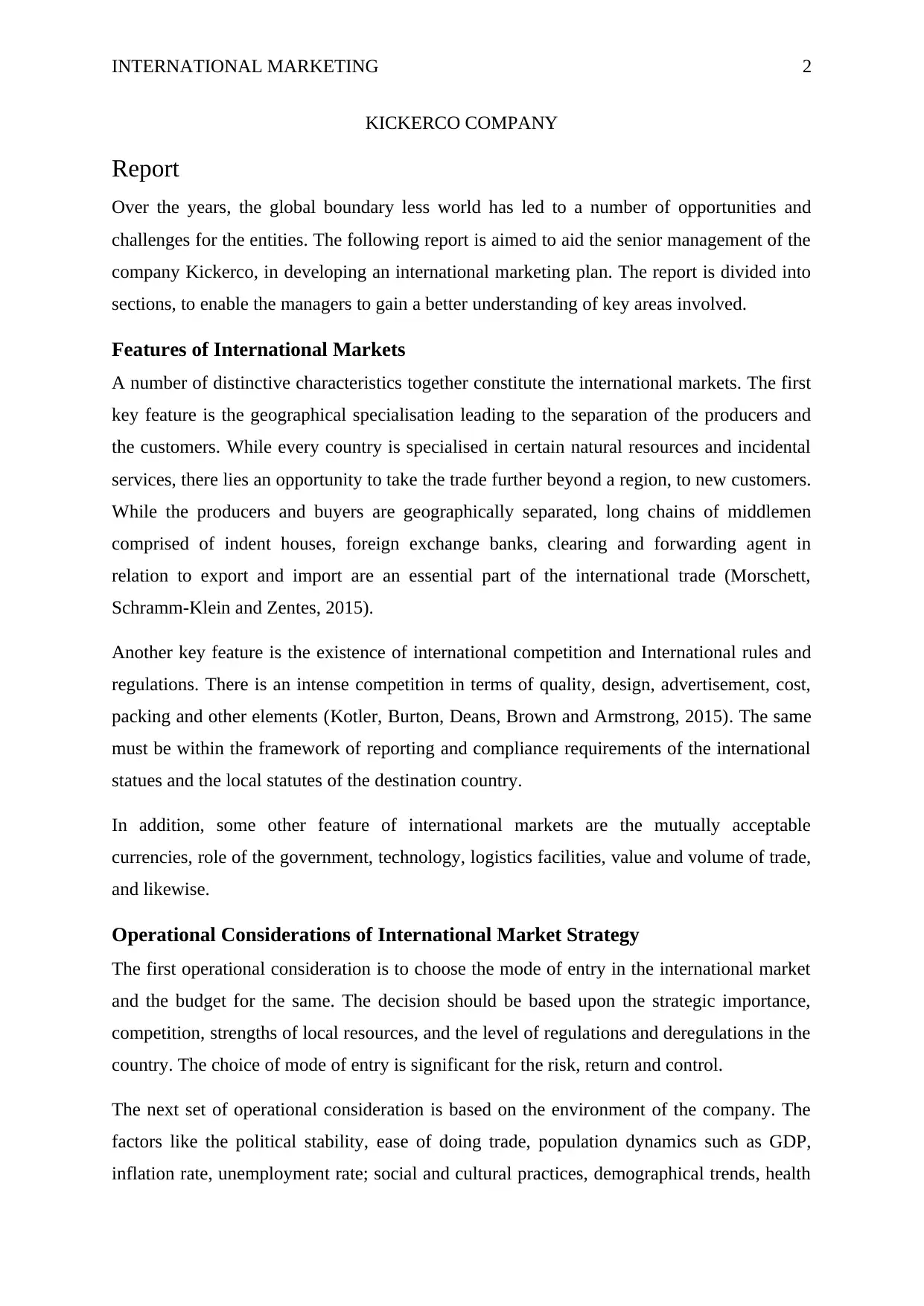
INTERNATIONAL MARKETING 2
KICKERCO COMPANY
Report
Over the years, the global boundary less world has led to a number of opportunities and
challenges for the entities. The following report is aimed to aid the senior management of the
company Kickerco, in developing an international marketing plan. The report is divided into
sections, to enable the managers to gain a better understanding of key areas involved.
Features of International Markets
A number of distinctive characteristics together constitute the international markets. The first
key feature is the geographical specialisation leading to the separation of the producers and
the customers. While every country is specialised in certain natural resources and incidental
services, there lies an opportunity to take the trade further beyond a region, to new customers.
While the producers and buyers are geographically separated, long chains of middlemen
comprised of indent houses, foreign exchange banks, clearing and forwarding agent in
relation to export and import are an essential part of the international trade (Morschett,
Schramm-Klein and Zentes, 2015).
Another key feature is the existence of international competition and International rules and
regulations. There is an intense competition in terms of quality, design, advertisement, cost,
packing and other elements (Kotler, Burton, Deans, Brown and Armstrong, 2015). The same
must be within the framework of reporting and compliance requirements of the international
statues and the local statutes of the destination country.
In addition, some other feature of international markets are the mutually acceptable
currencies, role of the government, technology, logistics facilities, value and volume of trade,
and likewise.
Operational Considerations of International Market Strategy
The first operational consideration is to choose the mode of entry in the international market
and the budget for the same. The decision should be based upon the strategic importance,
competition, strengths of local resources, and the level of regulations and deregulations in the
country. The choice of mode of entry is significant for the risk, return and control.
The next set of operational consideration is based on the environment of the company. The
factors like the political stability, ease of doing trade, population dynamics such as GDP,
inflation rate, unemployment rate; social and cultural practices, demographical trends, health
KICKERCO COMPANY
Report
Over the years, the global boundary less world has led to a number of opportunities and
challenges for the entities. The following report is aimed to aid the senior management of the
company Kickerco, in developing an international marketing plan. The report is divided into
sections, to enable the managers to gain a better understanding of key areas involved.
Features of International Markets
A number of distinctive characteristics together constitute the international markets. The first
key feature is the geographical specialisation leading to the separation of the producers and
the customers. While every country is specialised in certain natural resources and incidental
services, there lies an opportunity to take the trade further beyond a region, to new customers.
While the producers and buyers are geographically separated, long chains of middlemen
comprised of indent houses, foreign exchange banks, clearing and forwarding agent in
relation to export and import are an essential part of the international trade (Morschett,
Schramm-Klein and Zentes, 2015).
Another key feature is the existence of international competition and International rules and
regulations. There is an intense competition in terms of quality, design, advertisement, cost,
packing and other elements (Kotler, Burton, Deans, Brown and Armstrong, 2015). The same
must be within the framework of reporting and compliance requirements of the international
statues and the local statutes of the destination country.
In addition, some other feature of international markets are the mutually acceptable
currencies, role of the government, technology, logistics facilities, value and volume of trade,
and likewise.
Operational Considerations of International Market Strategy
The first operational consideration is to choose the mode of entry in the international market
and the budget for the same. The decision should be based upon the strategic importance,
competition, strengths of local resources, and the level of regulations and deregulations in the
country. The choice of mode of entry is significant for the risk, return and control.
The next set of operational consideration is based on the environment of the company. The
factors like the political stability, ease of doing trade, population dynamics such as GDP,
inflation rate, unemployment rate; social and cultural practices, demographical trends, health
⊘ This is a preview!⊘
Do you want full access?
Subscribe today to unlock all pages.

Trusted by 1+ million students worldwide
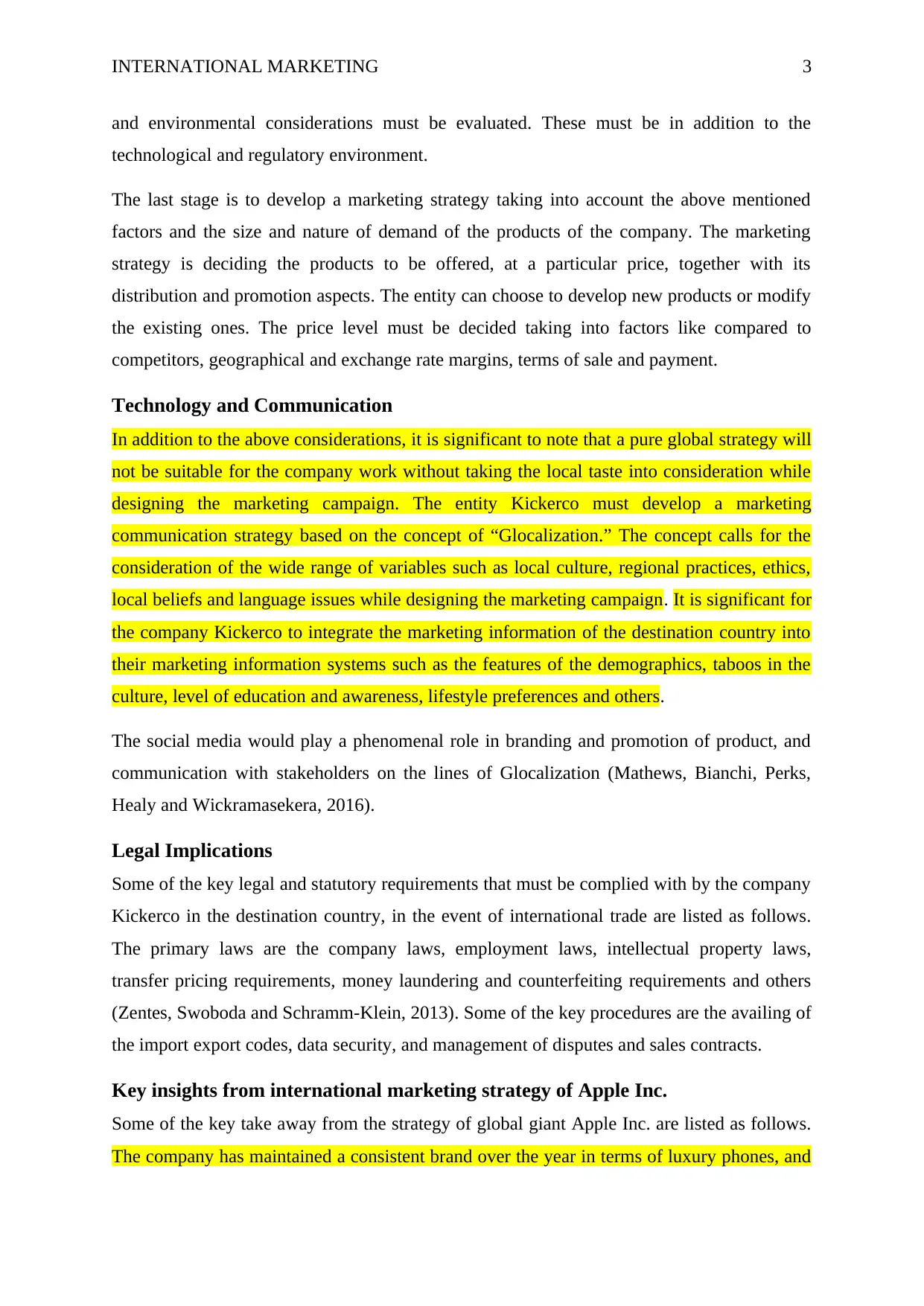
INTERNATIONAL MARKETING 3
and environmental considerations must be evaluated. These must be in addition to the
technological and regulatory environment.
The last stage is to develop a marketing strategy taking into account the above mentioned
factors and the size and nature of demand of the products of the company. The marketing
strategy is deciding the products to be offered, at a particular price, together with its
distribution and promotion aspects. The entity can choose to develop new products or modify
the existing ones. The price level must be decided taking into factors like compared to
competitors, geographical and exchange rate margins, terms of sale and payment.
Technology and Communication
In addition to the above considerations, it is significant to note that a pure global strategy will
not be suitable for the company work without taking the local taste into consideration while
designing the marketing campaign. The entity Kickerco must develop a marketing
communication strategy based on the concept of “Glocalization.” The concept calls for the
consideration of the wide range of variables such as local culture, regional practices, ethics,
local beliefs and language issues while designing the marketing campaign. It is significant for
the company Kickerco to integrate the marketing information of the destination country into
their marketing information systems such as the features of the demographics, taboos in the
culture, level of education and awareness, lifestyle preferences and others.
The social media would play a phenomenal role in branding and promotion of product, and
communication with stakeholders on the lines of Glocalization (Mathews, Bianchi, Perks,
Healy and Wickramasekera, 2016).
Legal Implications
Some of the key legal and statutory requirements that must be complied with by the company
Kickerco in the destination country, in the event of international trade are listed as follows.
The primary laws are the company laws, employment laws, intellectual property laws,
transfer pricing requirements, money laundering and counterfeiting requirements and others
(Zentes, Swoboda and Schramm-Klein, 2013). Some of the key procedures are the availing of
the import export codes, data security, and management of disputes and sales contracts.
Key insights from international marketing strategy of Apple Inc.
Some of the key take away from the strategy of global giant Apple Inc. are listed as follows.
The company has maintained a consistent brand over the year in terms of luxury phones, and
and environmental considerations must be evaluated. These must be in addition to the
technological and regulatory environment.
The last stage is to develop a marketing strategy taking into account the above mentioned
factors and the size and nature of demand of the products of the company. The marketing
strategy is deciding the products to be offered, at a particular price, together with its
distribution and promotion aspects. The entity can choose to develop new products or modify
the existing ones. The price level must be decided taking into factors like compared to
competitors, geographical and exchange rate margins, terms of sale and payment.
Technology and Communication
In addition to the above considerations, it is significant to note that a pure global strategy will
not be suitable for the company work without taking the local taste into consideration while
designing the marketing campaign. The entity Kickerco must develop a marketing
communication strategy based on the concept of “Glocalization.” The concept calls for the
consideration of the wide range of variables such as local culture, regional practices, ethics,
local beliefs and language issues while designing the marketing campaign. It is significant for
the company Kickerco to integrate the marketing information of the destination country into
their marketing information systems such as the features of the demographics, taboos in the
culture, level of education and awareness, lifestyle preferences and others.
The social media would play a phenomenal role in branding and promotion of product, and
communication with stakeholders on the lines of Glocalization (Mathews, Bianchi, Perks,
Healy and Wickramasekera, 2016).
Legal Implications
Some of the key legal and statutory requirements that must be complied with by the company
Kickerco in the destination country, in the event of international trade are listed as follows.
The primary laws are the company laws, employment laws, intellectual property laws,
transfer pricing requirements, money laundering and counterfeiting requirements and others
(Zentes, Swoboda and Schramm-Klein, 2013). Some of the key procedures are the availing of
the import export codes, data security, and management of disputes and sales contracts.
Key insights from international marketing strategy of Apple Inc.
Some of the key take away from the strategy of global giant Apple Inc. are listed as follows.
The company has maintained a consistent brand over the year in terms of luxury phones, and
Paraphrase This Document
Need a fresh take? Get an instant paraphrase of this document with our AI Paraphraser
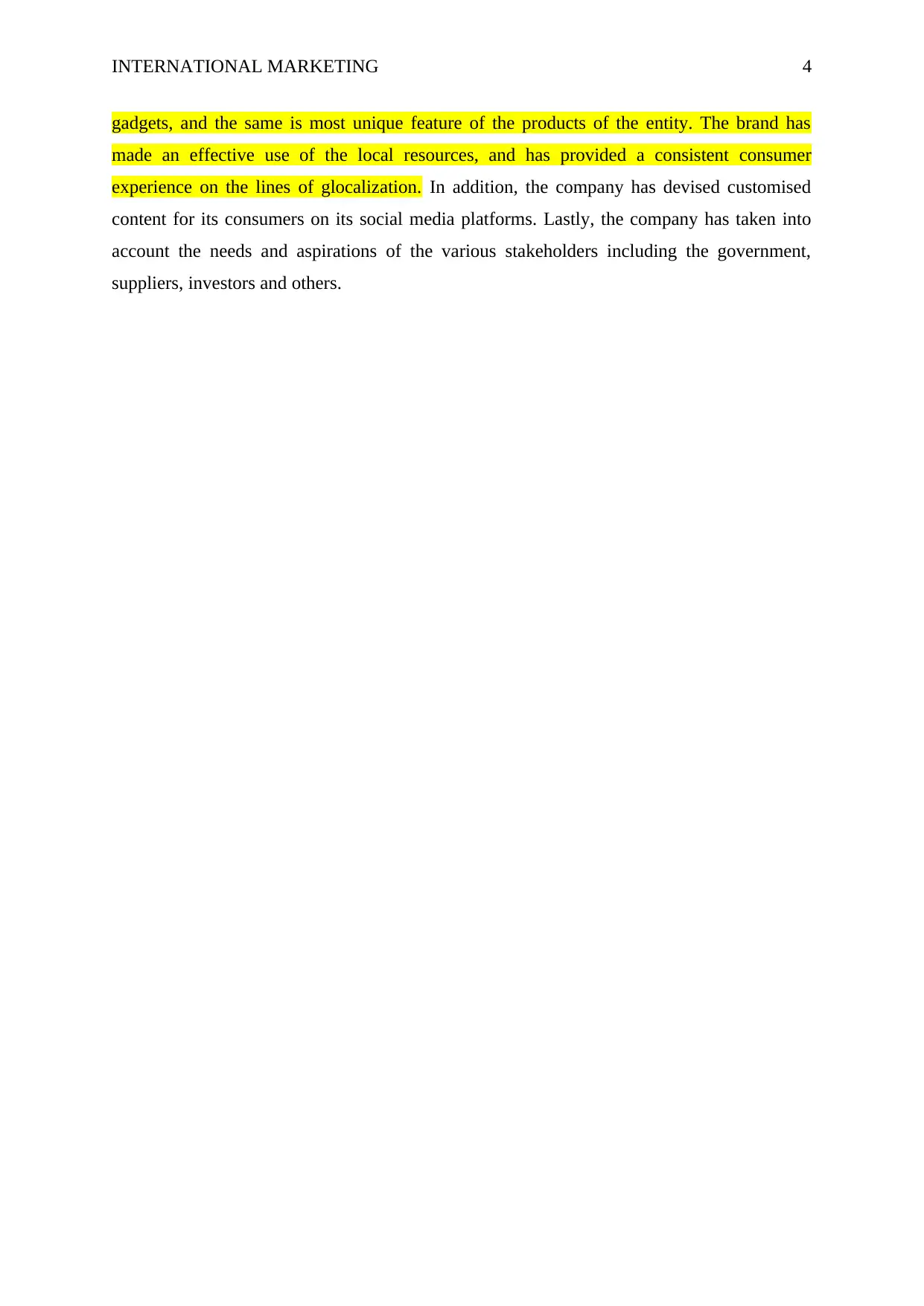
INTERNATIONAL MARKETING 4
gadgets, and the same is most unique feature of the products of the entity. The brand has
made an effective use of the local resources, and has provided a consistent consumer
experience on the lines of glocalization. In addition, the company has devised customised
content for its consumers on its social media platforms. Lastly, the company has taken into
account the needs and aspirations of the various stakeholders including the government,
suppliers, investors and others.
gadgets, and the same is most unique feature of the products of the entity. The brand has
made an effective use of the local resources, and has provided a consistent consumer
experience on the lines of glocalization. In addition, the company has devised customised
content for its consumers on its social media platforms. Lastly, the company has taken into
account the needs and aspirations of the various stakeholders including the government,
suppliers, investors and others.
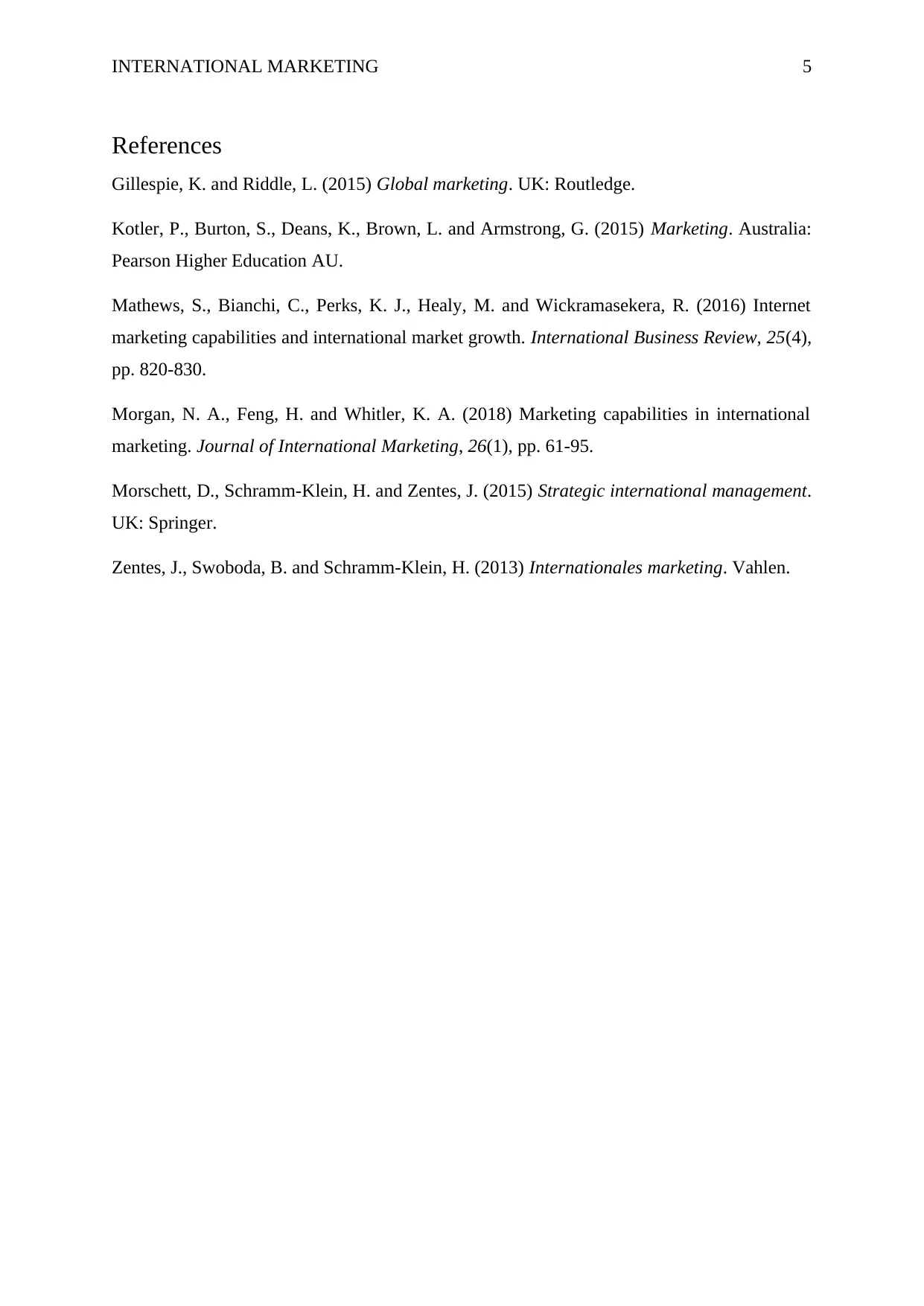
INTERNATIONAL MARKETING 5
References
Gillespie, K. and Riddle, L. (2015) Global marketing. UK: Routledge.
Kotler, P., Burton, S., Deans, K., Brown, L. and Armstrong, G. (2015) Marketing. Australia:
Pearson Higher Education AU.
Mathews, S., Bianchi, C., Perks, K. J., Healy, M. and Wickramasekera, R. (2016) Internet
marketing capabilities and international market growth. International Business Review, 25(4),
pp. 820-830.
Morgan, N. A., Feng, H. and Whitler, K. A. (2018) Marketing capabilities in international
marketing. Journal of International Marketing, 26(1), pp. 61-95.
Morschett, D., Schramm-Klein, H. and Zentes, J. (2015) Strategic international management.
UK: Springer.
Zentes, J., Swoboda, B. and Schramm-Klein, H. (2013) Internationales marketing. Vahlen.
References
Gillespie, K. and Riddle, L. (2015) Global marketing. UK: Routledge.
Kotler, P., Burton, S., Deans, K., Brown, L. and Armstrong, G. (2015) Marketing. Australia:
Pearson Higher Education AU.
Mathews, S., Bianchi, C., Perks, K. J., Healy, M. and Wickramasekera, R. (2016) Internet
marketing capabilities and international market growth. International Business Review, 25(4),
pp. 820-830.
Morgan, N. A., Feng, H. and Whitler, K. A. (2018) Marketing capabilities in international
marketing. Journal of International Marketing, 26(1), pp. 61-95.
Morschett, D., Schramm-Klein, H. and Zentes, J. (2015) Strategic international management.
UK: Springer.
Zentes, J., Swoboda, B. and Schramm-Klein, H. (2013) Internationales marketing. Vahlen.
⊘ This is a preview!⊘
Do you want full access?
Subscribe today to unlock all pages.

Trusted by 1+ million students worldwide
1 out of 6
Related Documents
Your All-in-One AI-Powered Toolkit for Academic Success.
+13062052269
info@desklib.com
Available 24*7 on WhatsApp / Email
![[object Object]](/_next/static/media/star-bottom.7253800d.svg)
Unlock your academic potential
Copyright © 2020–2025 A2Z Services. All Rights Reserved. Developed and managed by ZUCOL.




